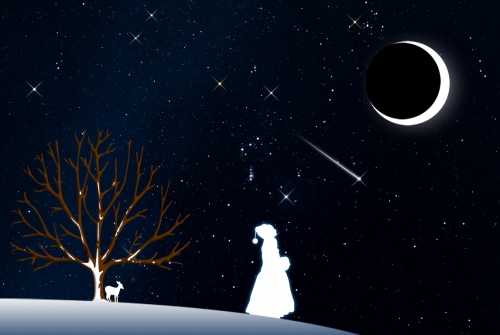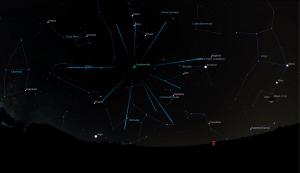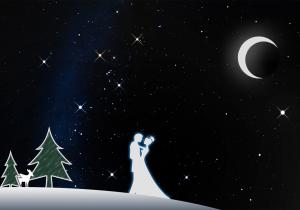
Stargazing Nights
- Where:
- Frosty Drew Observatory
- When:
- Fri, Dec 27, 2019 7:00 pm - 10:00 pm
- Cost:
- $5 Suggested Donation per person 5 years and older
Tonight is Stargazing Night at Frosty Drew Observatory, the last regular Stargazing Nights event of the decade! Forecasts are looking a bit variable at this time, with most sources calling for mostly cloudy skies, with clouds departing overnight. There is a slight chance of earlier clearings, offering up patchy conditions. Considering the 3% waxing crescent Moon sets at 5:46 pm, we will not have the Moon to bail us out with patchy cloud cover. Regardless, we could score with clearer than expected skies, as variability regular favors us at Frosty Drew Observatory.
We will open the Observatory, Sky Theatre, and Science Center at 7:00 pm tonight. In the Observatory, telescopes will start off on standby as we evaluate sky conditions on site. If skies are clear enough, we will observe what we can, which potentially includes the Messier 15 globular star cluster, The Orion Nebula, the Messier 37 open star cluster, R-Lepus – The Vampire Star, and Betelgeuse – the brightest star in Orion that is a known supernova candidate in the Milky Way. In the Sky Theatre we will show our regular feature of celestial objects photographed at Frosty Drew Observatory. The Science Center will host the works of Frosty Drew astronomers on gallery. We’ll stay open until 10:00 pm if skies are clear enough, 9:00 pm if skies are unobservable.
Overall, tonight is a tough call. Clouds will certainly be problematic, though how bad is up for debate. But this is the last Stargazing Nights event of the 2010’s, which could trigger a nostalgic note. Temps will be much warmer tonight than they have been, which will make for an easier night regarding comfort. Also, the lack of the Moon will bring super dark skies, which could work out awesome if skies are on the clear(er) side. If making the long drive, you may want to sit this one out. Otherwise, take a risk and come out to the dark of Ninigret Park for the last regular Stargazing Night of the decade, at Frosty Drew Observatory tonight!
-----------------------------
Weekly Happenings
Scott MacNeill
Tomorrow evening, Saturday, December 28, 2019, step outside about 30 minutes after sunset (sunset: 4:20 pm EST) and look to the Southwest. Venus and the super thin 7% waxing crescent Moon will be sitting about 2.5° apart as they put on a stunning celestial dance for the holidays. At that time, you will catch the conjunction in the deep blue of twilight, though as twilight wanes, the shadow side of the Moon will be strikingly visible as a ghostly glow alongside the bright crescent. This is called Earthshine, and happens due to sunlight reflecting off of Earth and onto the nighttime area of the Moon, causing it to glow subtly. At this time, forecasts are calling for clear skies over Southern New England, so get out and celebrate the season with a fabulous dance of the cosmos.
Overnight next Friday, January 3-4, 2020, the annual Quadrantid Meteor Shower will peak, bringing a potential increase in regular meteor upwards of 200 meteors per hour to the sky. The Quadrantid Meteor Shower has a very brief peak period, lasting only 3-6 hours in duration. Timings of the peak period have a significant impact on how awesome the shower will be. The radiant point of the shower, the defunct constellation Quadrans Muralis, is located in between the handle of the big dipper and the constellation Bootes. This region of the sky sits on the north horizon at 8:00 pm for our location, and will ride the NNE horizon until about 9:30 pm, after which it will start to rise. The higher in the sky the radiant point the better the shower. This year, peak period predictions place the start of the meteor shower peak at around 3:00 am EST on January 4th, with the shower wrapping up after sunrise. This is excellent timing for a few reasons. First the radiant point of the shower will be over 40° off the horizon and rising nearly overhead during the peak period, which is fantastic for catching the highest rates. Secondly, the 58% waxing gibbous Moon sets at 12:49 am, which will put the peak under fabulously dark skies. Now all we need are clear skies, and accurate peak prediction times. As usual Frosty Drew Observatory plans to open for the meteor shower peak, and considering it’s on a Friday night, it will coincide nicely with our regular Stargazing Nights event. Learn more about our Quadrantid event, then welcome the new decade with the second best meteor shower of the year, and the last of regular meteor showers until the Lyrids in late April.
Save the Date:
On New Years Eve – Tuesday, December 31, 2019 from 7:00 pm to 9:00 pm, Frosty Drew Observatory will open for quick bout of stargazing to shake off the decade and start the 2020’s. Our event follows the annual New Year’s Eve bonfire that the Town of Charlestown puts on in Ninigret Park (home to Frosty Drew Observatory), which starts at 4:30 pm. What better way to ring in the New Year than a night of fire and stars! So add Frosty Drew to your night of year-end revelries and send off the decade in cosmic style!
Have a safe and Happy New Year from all the astro-geeks at Frosty Drew Observatory!
-Scott
Check out our page on Visiting Frosty Drew Observatory to learn more about what to expect at the Observatory and better help you prepare for your visit.
Please note that we do not allow any white lights on our campus from dusk - dawn. This is to ensure an equally awesome view of the night sky for all and to allow for the use of light sensitive astronomical equipment. Learn more about why we have this requirement in The Red Light District



